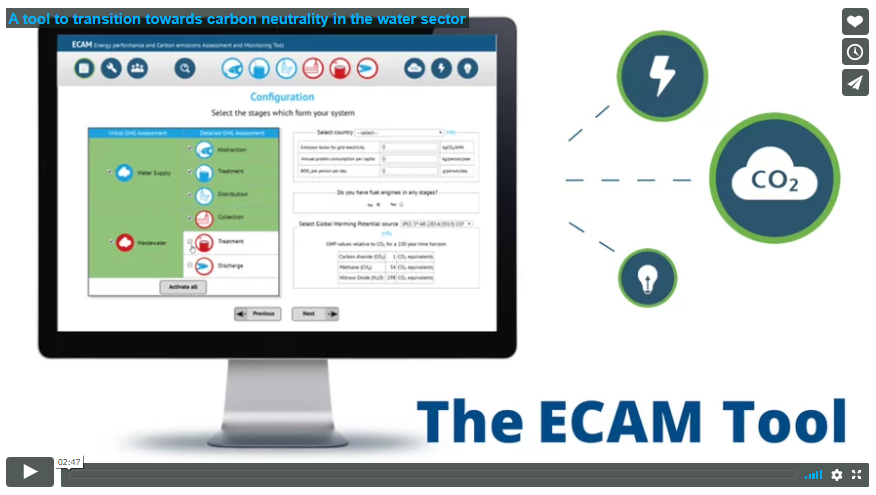A new tool to decarbonise the wastewater sector

ECAM is the world’s first holistic tool for measuring and reporting greenhouse gas emissions from urban water services
The global community is coming increasingly to recognise the important role of water in climate change adaptation and mitigation. As water is an essential link between different sectors, the High-Level Water Action Day at the UN Climate Change Conference COP23 in Bonn, Germany, aims to mainstream water into the global climate action agenda. This will enable those involved in climate protection and the water sector to learn from each other, and to work as partners to achieve a sustainable, low-carbon and climate-resilient future for all. The project Water and Wastewater Companies for Climate Mitigation (WaCCliM) contributes to this goal by promoting solutions for a shift to a low-carbon water future.
One of these solutions is a free, new open-source tool that can help urban water utilities introduce low-energy, low-carbon water management practices. The Energy Performance and Carbon Emissions Assessment and Monitoring (ECAM) tool was launched during the Stockholm World Water Week, in August 2017.
Water and wastewater utilities are among the largest consumers of energy, particularly in developing countries and emerging economies. They also emit larger quantities of greenhouse gases (GHG) than necessary. The water sector could therefore contribute significantly to achieving the target of the Paris Agreement of restricting global warming to an increase of well below 2°C, and it could play a part in each country’s Nationally Determined Contributions (NDCs). At present, there is only limited awareness of this opportunity.
"The contribution of the water sector to greenhouse gas emissions is complex and therefore often under-recognised. ECAM helps utilities develop an emissions baseline, identify areas of improvement to reduce indirect and direct emissions, and monitor their progress over time."
Astrid Michels, Project Manager of WaCCliM

The ECAM tool enables utilities to measure and manage their GHG emissions and energy consumption across their entire system. They can use it to develop scenarios and model the potential impacts of reductions under future measures. It also allows them to monitor the results of GHG reductions after measures have been implemented, and can help them prepare for their future reporting requirements on climate change mitigation. Finally, ECAM also helps to connect the Monitoring, Reporting and Verification (MRV) of mitigation actions in the water sector to those at the national level.

The ECAM tool draws on the methodology used in the Intergovernmental Panel on Climate Change (IPCC) Guidelines for National Greenhouse Gas Inventories. It was created as part of the WaCCliM project by the International Water Association (IWA), the Deutsche Gesellschaft für Internationale Zusammenarbeit (GIZ) GmbH and the Catalan Institute for Water Research (ICRA).

Under the WaCCliM project, which is funded as part of the International Climate Initiative (IKI) of the German Environment Ministry (BMUB), pioneering utilities have started looking at ways to decarbonise their activities and optimise their overall efficiency. Utilities in Jordan, Mexico, Peru and Thailand have already used the ECAM tool to achieve dramatic reductions in GHG emissions.
The city of Madaba in Jordan joined WaCCliM in 2016 and is using ECAM to assess its carbon footprint as a prerequisite to securing funds for its low-carbon water and wastewater infrastructure, and so help meet its GHG reduction potential.

San Francisco del Rincón in Mexico has achieved an almost 50 per cent reduction in its total GHG emissions, compared to the baseline established using ECAM in 2014. It did this by treating more wastewater in order to reduce methane emissions, and by improving its pumping efficiency. Additional measures have been identified that could bring a 65 per cent reduction in total emissions.

Cusco in Peru has saved 5,300 t CO2 emissions per year, which amounts to 20 per cent of its total carbon emissions. A total GHG reduction potential of 30 per cent has been identified, based on greater pumping efficiency and wastewater reuse.
The city of Chiang Mai in Thailand has used the ECAM tool to establish baseline values for its municipal wastewater treatment, and it identified a 12 per cent GHG reduction potential.
"As cities and water utilities recognise the significant opportunities to reduce GHG emissions, improve service quality, water and energy efficiency in water supply and wastewater treatment, tools like ECAM are helping them to focus on the areas of largest potential impact and economic return. The C40 Cities organisation looks forward to collaborate on the WaCCliM Project to increase the ambition of cities and water utilities to reduce emissions in the water sector and to contribute towards meeting the Paris Agreement targets."
Ricardo Cepeda-Marquez, Head of the Water & Waste Initiative at C40 CITIES
In addition to the pilot schemes, utilities in over 20 cities have now used the tool to assess potential GHG reductions and drive the process. The C40 Cities Climate Leadership Group recently endorsed ECAM as a means of empowering cities around the world to measure the emissions produced by their urban water systems, identify and plan measures to reduce those emissions, and ultimately achieve the transition to a resilient, low-carbon future.
More and more, the global community recognising the importance of water, not only for adaptation to climate change, but also for climate mitigation. At this year’s UN Climate Change Conference COP23 in Bonn, WaCCliM will help to raise awareness about the link between water and climate.
The link has been copied to the clipboard
Contact
IKI Office
Zukunft – Umwelt – Gesellschaft (ZUG) gGmbH
Stresemannstraße 69-71
10963 Berlin















